Interest
Making Money with Your Money
Compound interest is the process where interest is calculated on the initial principal, which also includes all of the accumulated interest from previous periods. This powerful financial concept can significantly enhance the growth of an investment over time. Unlike simple interest, which is only calculated on the principal amount, compound interest allows your money to grow at an accelerating rate.
Illustration
To illustrate the power of compound interest, consider the following example: If you invest $1,000 at an annual interest rate of 5% compounded annually, after one year, you would have $1,050. In the second year, interest is calculated on the new principal of $1,050, resulting in $1,102.50, and so forth. Over time, this compounding effect leads to exponential growth of your investment.
There are mathematical formulas used to calculate Future Value based on Compound Interest.
Benefits of Compound Interest
The benefits of compound interest are manifold:
Accelerated Growth: Your investment grows faster as interest is earned on both the principal and previously earned interest.
Long-Term Wealth Accumulation: The longer the investment period, the greater the growth due to compounding.
Encourages Early Investing: Starting early can significantly increase the future value of your investments.
Higher Returns: Compared to simple interest, compound interest yields higher returns, making it an attractive option for saving and investing.
Simplified Examples of the Impact of Investing with Compound Interest
For any Future Value look ahead, it is important to factor in inflation. This is called the Real Future Value. For simplicity, these examples are based on annual compound interest, products with monthly compounding will yield higher amounts. in these examples we will use industry standard interest rates (APY) and inflation of 3% per year.
Roll Over Example 1
In this example we will assume a rollover of $100,000 from a 401(k) plan at age 60 (Yes this can be done without penalty or interest, even if you are still contributing to the plan). Additionally, we will assume the 401(k) has an APY of 6.5% (typical APY range 5-8%). Further we will assume an Annuity APY of 10% (typical APY range 8-14%). And we will calculate the Real Future Value based on 3% inflation. We will look at the Future Value and Real Future Value at age 65 (5 years).
In figure Roll_60_65, we can see that moving the 401(k) to an Annuity provides a gain of $21,487, very nice vs if we left it in the 401(k).
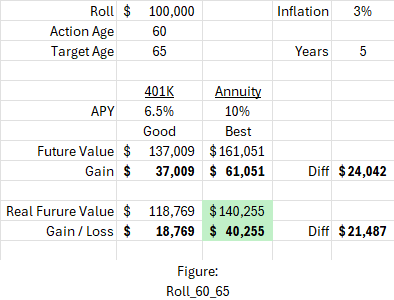
Roll Over Example 2
We will use the same metrics as Roll Over Example 1 except we will look at the value at age 67 (7 years).
In figure Roll_60_67 we can see what an additional 2 years can yield a Real Future Value of gain of $33,350.
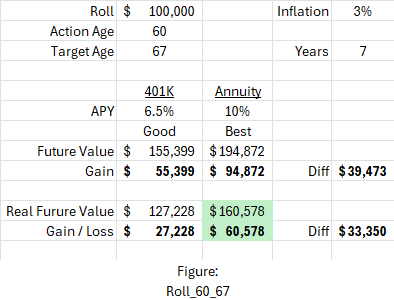
Roll Over Example 3
Same metrics as Roll Over Example 1 except we look at the value at age 70 (10 years).
Wow, in figure Roll_60_70 we can see that 10 years makes a significant difference of $55,655 Real Future Value gain.
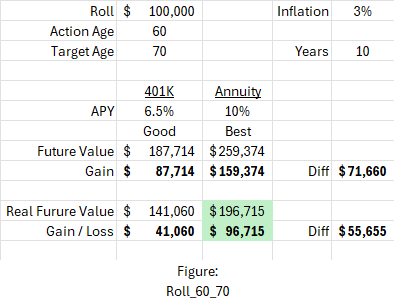
Savings Over Time Example 1
In this example we will assume a stating age of 50 and a monthly contribution of $500 per month and a target age of 67 (17 years).
In figure Invest_50_67 we can see that keeping your money in a mattress, the Real Future Value is negative $21,165. Keeping it in a checking account that pays 2% interest is a $7,766 loss. However, investing it into a Annuity yields a Real Future Value gain of $83,041.
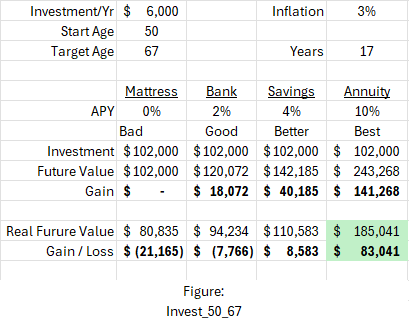
Savings Over Time Example 2
In this example we will use the same metrics as Savings Over Time Example 1 except use a stating age of 30 (35 years).
In figure Invest_30_67 we can see that time is our friend allowing the money to make money and really grow. We get almost 4 times the Real Future Value gain from the money invested.
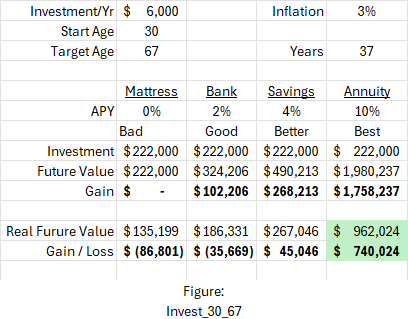
Summary
Understanding the power of compound interest is
crucial for sound financial planning. By leveraging this powerful
tool, you can maximize your investment growth, achieve your
financial goals, and secure a more prosperous future. It is a
testament to the adage, "The earlier you start, the better off
you'll be."
Inflation < Chapter 1 > Rule of 72

Page Last Updated: 20 March 2025